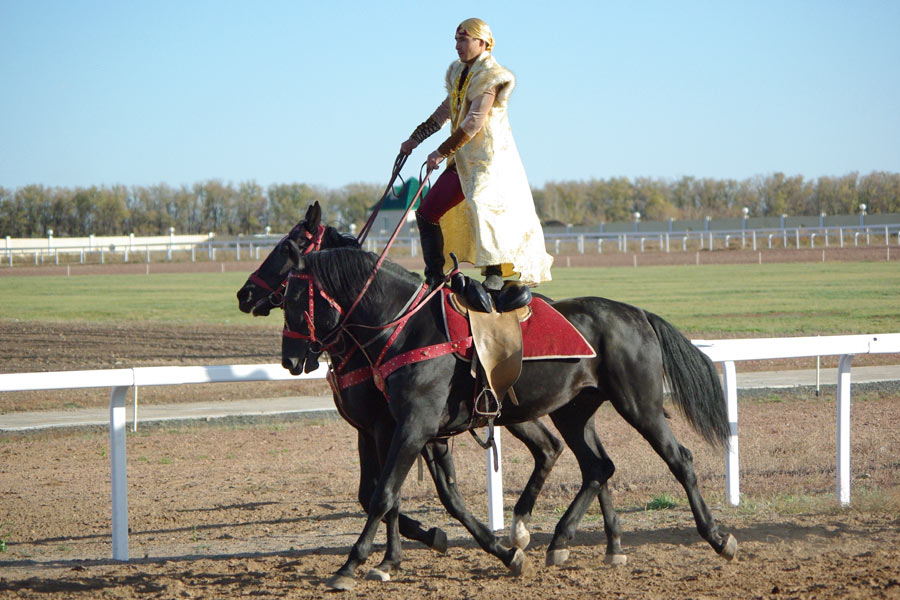
Equestrian skills are essential to the nomadic way of life on which Kazakh culture is based. Over thousands of years of societal development, Kazakhs developed horse games to compete and have fun but also to improve strength, agility, and dexterity while riding. Some of the games are rooted in the survival methods of the distant past while others are only for entertainment at the holidays—every game helps to develop a spiritual unity and camaraderie amongst the Kazakh people. Kazakhs have worked to preserve these games despite developing a more sedentary lifestyle, and today, no major celebration would be complete without them.
Alaman Baiga
Alaman Baiga is characterized as long-distance racing for local horse breeds. Nomadic culture demands a readiness for long journeys, which necessitated the breeding of strong horses with unmatched endurance. Alaman Baiga provides a test for locally bred horses over the course of 30, 50, or even 100 km of rough terrain. Riders often braided the horses’ tails and manes or bird feathers and other decorations were used to protect the horse from harm—not all of the horses survived the races, however. Today, this equestrian game is still popular among Kazakhs, but it is held in hippodromes, where a 30 km races are organized.
Baiga
Shorter-distance races are called Baiga. Baiga is either two, five, or nine kilometers across level ground. There are different divisions based on the horse’s age—for those horses younger than three years old, the races are up to two kilometers; horses younger than four race up to five kilometers; and horses older than five years race the longest distance: nine kilometers. Baiga is held during many holidays and anyone who has a horse can participate in the competition.
Kokpar
The ancient game of Kokpar (and its team version, Ulak) is not only part of the culture of Kazakhstan but also the other nations of Central Asia. The goal of the game is to lift the carcass of a ram and deliver it to a certain point or throw it into a huge cauldron. Riders showcase great strength, a firm grip, and supreme balance in the saddle while leaning to the ground to grab the ram. The name “Kokpar” translates from the Kazakh as “Blue Wolf”. The origin of this name is associated with the following legend: in ancient times, during the winter, nomads staged hunts for wolves. Upon returning home, the hunters entertained themselves by fighting for the predator’s carcass. Over time, this hunting tradition became a game, the carcass of the wolf was replaced by a sheep, and competitions began to be held during major holidays. Today, this game is considered the official equestrian sport in Kazakhstan, Uzbekistan, Kyrgyzstan and other Central Asian countries. The largest Kokpar championship is held as part of the Games of Nomads, usually held in Kyrgyzstan.
Audaryspack
Audaryspack is Kazakh wrestling on horseback. Rivals try to knock their opponents off their horses via grabs, holds, and so on. An ancient game, Audaryspack is excellent training for warriors as it develops not only wrestling ability but grip strength in the saddle. A century ago, this game was considered mandatory and was learned from childhood—boys staged fights sitting on foals, rams, and bulls. There were also experts in horse selection who were able to identify the strongest, most nimble horses.
Kyz Kuu
This fun tradition of Kazakhstan and Kyrgyzstan translates as "catch up with the girl". Kyz Kuu is held during holidays and festivals, with young girls and boys participating in the game. The young people perform in bright national costumes and adorn their horses, providing a colorful show for elders and tourists alike. At the signal, the girl sets off on her horse. A few seconds later, the boy rushes after her, trying to get a kiss. If he is unable to get a kiss by the finishing point, she has license to chase him back to the start, trying to hit him with a whip. Usually, the chase distance in one direction is 400-500 meters.
Kume Alu
“Pick up the coin”, as this name is translated from Kazakh, is a game in which the rider must gather as many coins as possible. The coins are wrapped in small scarves and laid out in a line. The rider who collects the most coins is the winner. This game requires excellent dexterity, balance, and a strong grip whilst hanging down to scoop up the coins.
Tymak Uryp Zhygu
Tymak Uryp Zhygu is an entertaining game which anyone with a horse can take part in. In this game, a pole of a little more than two meters high is installed on a platform. A headdress called a tymak is placed atop the pole. Participants look at the tymak and are subsequently blindfolded, given a whip, sat on their horses, and spun around several times. The rider then has three attempts to knock the tymak off the pole with the whip. If unable to do so, three more attempts can be earned by performing a song or merry dance. This game is most commonly played during the major holidays.

